
The panther chameleon is a species of chameleon found in the eastern and northern parts of Madagascar in a tropical forest biome. Additionally, it has been introduced to Réunion and Mauritius, as well as the state of Florida within the United States.

Parson's chameleon is a species of chameleon in the family Chamaeleonidae that is endemic to eastern and northern Madagascar where it mainly inhabits humid primary forest and less frequently is found in disturbed habitats. For a chameleon, it is very large, long-lived and slow-reproducing.

The Malagasy giant chameleon or Oustalet's chameleon is a large species of chameleon which is native to entire Madagascar, but also has been introduced near Nairobi in Kenya and in Miami-Dade County in the United States. It occurs in a wide range of habitats, even among degraded vegetation within villages, but is relatively rare in the interior of primary forest.
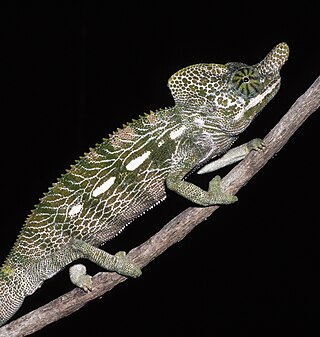
Labord's chameleon is a species of chameleon, a lizard in the family Chamaeleonidae. The species is endemic to dry and deciduous forests, including spiny forests, in lowlands of western Madagascar. It is considered vulnerable because of ongoing habitat loss.

The jeweled chameleon, also commonly known as Campan's chameleon or the Madagascar forest chameleon, is a species of lizard in the family Chamaeleonidae. The species is endemic to the central highlands of Madagascar, where it is threatened by bush fires and habitat loss.

The lesser chameleon or minor chameleon is a species of lizards in the family Chamaeleonidae. It is endemic to Madagascar.

The rhinoceros chameleon is a species of chameleon that gets its common name from its horn-like nose which is most prominent in males. It is endemic to dry forests in Madagascar.

The Angel's chameleon, initially described as Chamaeleo angeli, is a species of chameleon, a lizard in the family Chamaeleonidae. The species is endemic to Madagascar, and was originally described by Édouard-Raoul Brygoo and Charles Antoine Domergue in 1968.

Furcifer balteatus, also known as the two-banded chameleon or the rainforest chameleon, is a species of chameleon that is endemic to Madagascar. It was described by André Marie Constant Duméril and Gabriel Bibron in 1851.

The canopy chameleon, also known commonly as Wills's chameleon or incorrectly as Will's chameleon, is a species of lizard in the family Chamaeleonidae. The species is endemic to Madagascar. The species was originally described by Albert Günther in 1890.

The Mayotte chameleon is a species of chameleon that is endemic to Mayotte in the Comoros Islands. It was first described by Wilhelm Peters in 1874.

The carpet chameleon, also known as the jewel chameleon or white-lined chameleon, is a species of chameleon that is endemic to eastern Madagascar. It is a relatively small chameleon and especially females tend to have bright markings in many colours, whereas males are mostly green and whitish or green and yellowish.

Furcifer belalandaensis, also commonly known as the Belalanda chameleon or the Sangoritan'i Belalanda, is a species of chameleon that is endemic to Madagascar. It was identified and described by Édouard-Raoul Brygoo and Charles Domergue in 1970. The International Union for Conservation of Nature rated this species as Critically Endangered on their Red List of Threatened Species. The World Wide Fund for Nature is trying to save this species from extinction.

Furcifer nicosiai is a large species of chameleon, a lizard in the family Chamaeleonidae. The species is endemic to western Madagascar. Described as new to science in 1999, it was ranked as an endangered species by the International Union for Conservation of Nature (IUCN). It has only been found in the Tsingy de Bemaraha National Park at levels of 57 and 571 metres above mean sea level.

Furcifer tuzetae is a species of chameleon that is endemic to Madagascar. It is only known from its type locality, Andrenalamivola near Befandriana Sud. It was described by Édouard-Raoul Brygoo, Robert M. Bourgat and Charles Antoine Domergue in 1972. The International Union for Conservation of Nature have rated this species as "data deficient".

The Petter's chameleon is a species of chameleon, which is endemic to northern Madagascar. Furcifer petteri was initially described as the subspecies Chamaeleo willsii petteri by Édouard-Raoul Brygoo and Charles Domergue in 1966, but later transferred to the genus Furcifer and given full species status by Frank Glaw and Miguel Vences in 1994.
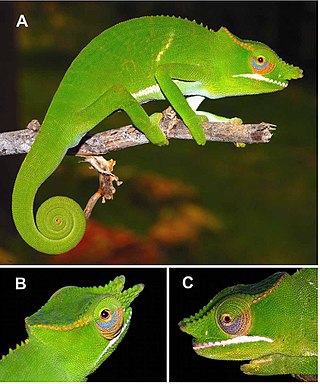
Furcifer timoni is a species of chameleon, a lizard in the family Chamaeleonidae. The species is endemic to Madagascar.
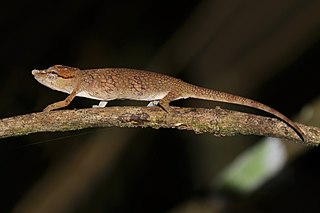
Calumma fallax, the deceptive chameleon or short-nosed deceptive chameleon is a species of chameleon endemic to eastern Madagascar, where its type locality is the Ikongo forest. It was first described by François Mocquard in 1900 as Chamaeleon fallax, and it was first recognized as Calumma fallax in 1986. It is a member of the Chamaeleoninae nominotypical subfamily of chameleons, and is believed to be found over an area of 2,057 km2 (794 sq mi), although the population is unknown.
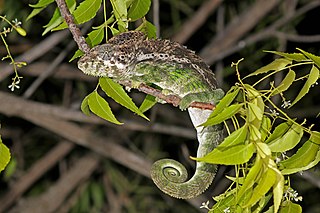
Furcifer verrucosus, also known as the warty chameleon, spiny chameleon or crocodile chameleon, is a species of small reptile endemic to Madagascar. It was first described by Georges Cuvier in 1829.
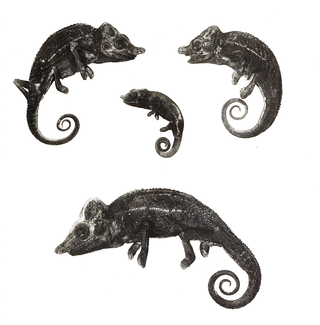
Voeltzkow's chameleon is a species of chameleon that is endemic to Madagascar. The species was described by Oskar Boettger in 1893, from an adult male specimen collected by A. Voeltzkow.






















